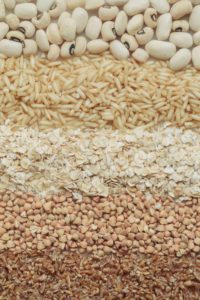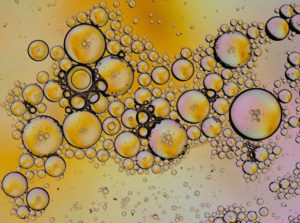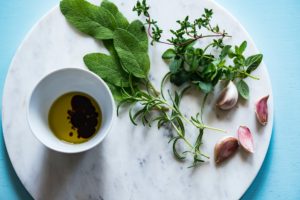Many see plants as colorful helpers and endless sources of nutrients. I’d make the point they are not!
Plants are their own kingdom of nature and as such interested in their own survival.
As paleoanthropologist Bill Schindler aptly writes in his book ‘The Modern Stone Age Diet*’:
‘Plants should scare the hell out of you’. Plants can neither run away nor directly defend themselves, they must use mechanical protection (think bark or thorns) or a wide arsenal of chemical toxins. This is how they defend themselves from predators and ensure their reproductive processes.
Although humans are omnivores, we do not specialize in eating plants. We are omnivores by technology – it was biochemical technologies like sourdough fermentation that enabled us to eat grain. Thus we’re able to pre-digest it, with the help of bacteria that do the job our organism is incapable of doing.
This frees up nutrients while reducing toxins. Even herbivores can only eat from some plants to a limited extent and have to rotate through different species to diversify their nutrient- & toxin portfolio.
And here we come to the topic of today’s post, precisely these plant defense molecules – the antinutrients. We’ll take a close look at what substances are found in common plants that people eat today, why they’re problematic, and what you can do about it.
What are Antinutrients?

Plants defend themselves through mechanical or chemical warfare.
Those plant parts are generally defended:
- Components of their reproduction (seeds, kernels, grains, legumes).
- Energy and nutrient stores (roots & tubers)
- Energy producers (leaves)
Basically, plants only want their fruits to be eaten so that mobile animals can carry away the seeds they contain. That is why fruits are very poor in antinutrients, full of color particles, and contain sugar or fat. A tasty Trojan horse.
Antinutrients can be seen as poison. They oppose nutrients.
Some plants are enormously toxic, others less so. Antinutrients are generally less toxic molecules, but chronic exposure will certainly cause problems. Especially in our world, where we always eat the same plants all year.
Which Antinutrients are there in common foods?
There are many antinutrients. They are also found in almost all plant parts, except for most fruits. We will now look at the most significant ones in food and the mechanisms by which they work.
Phytic Acid

Phytic acid is a phosphorus-containing substance. In plants, it is important for storing phosphorus.
In the human body, phytic acid binds minerals to itself, making them unavailable to our body. It binds especially to iron, zinc, copper, calcium, and magnesium. This bound complex of phytic acid and minerals is then called phytate. More about this in my post on phytic acid.
Phytates can also downregulate certain digestive enzymes in their work, such as pepsin, amylase, or trypsin. These are needed to break down proteins and carbohydrates.
The effects of phytic acid can be reduced if they are eaten together with fat-soluble vitamins such as vitamin A from beef liver, for example. Phytic acid also showed antioxidant abilities as it can bind excess iron and heavy metals to itself in the intestines. Although this is exciting for therapy, I would not take phytates as an endogenous antioxidant.
Phytic acid is found in cereals, legumes, nuts, and oilseeds.
Lectins
Lectins react with carbohydrates of all kinds. After eating, they cause great damage to the human body:
- Prevent the absorption of minerals such as zinc, copper, and calcium.
- Damage the intestinal wall and are closely associated with ‘leaky gut’.
- Increase inflammation and may contribute to autoimmune diseases
- Bind to specific carbohydrates called AGEs, and thus can accelerate aging1https://www.researchgate.net/figure/Lectins-bind-to-AGEs-AGE-modified-and-sham-modified-BSA-and-collagen-were-adsorbed-to_fig2_272640486
- Studies show that lectins in model organisms can enter the brain via the vagus nerve, in the substantia nigra of the basal ganglia, whose pathology is closely linked to Parkison’s.2Dietary Plant Lectins Appear to Be Transported from the Gut to Gain Access to and Alter Dopaminergic Neurons of Caenorhabditis elegans, a Potential Etiology of Parkinson’s Disease
They are found in particular in legumes, nuts, and beans. But cereals and nightshade plants also contain lectins.3https://www.doctorkiltz.com/lectins/
Enzymatic Inhibitors
This group of substances hinders digestive enzymes from performing their function. A wide range of our enzymes can be attacked in the process:
- Protein digesting enzymes: pepsin, proteases, trypsin, chymotripsin4https://en.wikipedia.org/wiki/Proteinase_inhibitors_in_plants
- Fat digesting enzymes: lipases5https://en.wikipedia.org/wiki/Lipase_inhibitors
- Carbohydrate digesting enzymes: Amylase
And indeed, there are some substances that do. Quantitatively, they are found in the extremely strongly defended ‘plants to be’ such as nuts, pods, grains, and seeds.
Phytoestrogens

Phytoestrogens are substances that act like estrogen in our body.
Phytoestrogens act just like estrogen, with devastating effects. Most women already have too much estrogen in their bodies due to the effects of contraceptives and environmental toxins– no wonder cancers like breast cancer are going through the roof!
Men’s testosterone levels have likewise been on a downward slide for a century. Phytoestrogens in the diet potently contribute to that multifactorial trend.
Personally, at the beginning of my ‘fitness journey’, I ate vast quantities of flaxseed. Followingly I developed a gynecomastia, which fortunately receded after I did my research and cut them out. Interestingly, no doctor believed me and told me to get off gear. I’ll take that as a compliment….6Effect of oral contraceptives on balance in women: A randomized controlled trial + Oral contraceptives cause evolutionarily novel increases in hormone exposure
Phytoestrogens are found in particular in soy and flaxseed. However, less is also contained in pistachios, other nuts, raisins, and legumes.7https://www.doctorkiltz.com/phytohormones/
Goitrogens
These substances manipulate the function of your thyroid gland. Sometimes they are also called glucosinolates. Goitrogens contribute to an underactive thyroid and this causes it to grow – also called a goiter. In addition to goiter, they can also contribute to autoimmune thyroid diseases such as Graves’ or Hashimotos’.
There are several goitrogens in plants, and they are clearly defensive substances as they are only activated in the body of the predator. Goitrin is the most famous example coming from various cruciferous plants: It is activated in the body by the plant enzyme myrosinase after the plant’s cell membranes have been damaged.
Goitrogens reduce the uptake of iodine and thus manipulate the conversion of the storage form (T4) into the active form of thyroid hormone (T3).8Various Possible Toxicants Involved in Thyroid Dysfunction: A Review
Tannins
Tannins are a certain group of polyphenols found for example in wine, grapes or green tea.
Like enzyme inhibitors, tannins prevent enzymes from doing their job properly. In people who eat a lot of tannins, a reduced usability of proteins, for example, has thus been demonstrated.9The inhibition of digestive enzymes by polyphenolic compounds + Inhibition of α-amylase and glucoamylase by tannins extracted from cocoa, pomegranates, cranberries, and grapes
Oxalates
We make oxalates both in small amounts in the body, but they occur in much larger amounts in plants from the diet.
The problem with them is that the body cannot metabolize them, but must actively dispose of them. In addition, the rate of disposal is heavily-dependent on good redox function, as well as healthy mitochondria.10Oxalate induces mitochondrial dysfunction and disrupts redox homeostasis in a human monocyte derived cell line
Under the microscope, oxalates look like little needles, made of crystals. Called raphenes, these structures are made of oxalates. And interestingly, they can act just like needles in the body.
Too many oxalates can cause this problem in the body11https://sallyknorton.com/oxalate-science/oxalate-basics/:
- Prevent the absorption of other minerals during digestion
- Attack, reduce, and even perforate the inner wall of the intestine
- Stresses the kidneys in excretion and thus appears to be the primary cause of kidney stones.
- Triggers inflammatory processes in various tissues
- Prevents hyaluronic acid from functioning for healthy connective tissue
- and many others, as it can be stored in many body tissues.
Oxalates are most abundant in nuts, seeds and also leafy vegetables.
Non-proteinergic Amino Acids
In the body, we use around 20 amino acids and build all our proteins from them. In nature thousands more exist. Plants often use amino acids as a defense method. They work by resembling certain amino acids of ours and being incorrectly incorporated by our body’s machinery.

Some representatives of the known-harmful amino acids of plants are:
- L-Canavanine from alfalfa sprouts12Effects of L-canavanine on T cells may explain the induction of systemic lupus erythematosus by alfalfa
- Acetidine-2-carboxylic acid from various tubers such as beetroot
One interesting example is the proline analog azetidine, which is incorporated instead of the body’s own amino acid proline when ingested. Doesn’t sound like much, but this destroys the function of the proteins it is incorporated into – they degenerate. An interesting theory underlies this mechanism in certain neurodegenerative diseases such as multiple sclerosis or Alzheimer’s disease, which are characterized by misfolded proteins.
There are other substances that function in the same way as furanocoumarins, which are found in root vegetables such as carrots. They accumulate within the skin, and are activated by solar radiation, where they damage the surrounding tissues upon acitvation.13Furanocoumarin content and phototoxicity of rough lemon (Citrus jambhiri) foliage exposed to enhanced ultraviolet-B (UVB) irradiation + https://natoxaq.ku.dk/toxin-of-the-week/bergapten/
Those have not been all!
In addition to these main players, there are many other plant compounds that potently mess with our metabolism. Some more are:
- Isoflavones
- Solanine
- Chaconine
- Gluten
Dr. Bill Schindler was probably right in his quote after all, that eating plants is not all that positive per se, but has risks that need to be weighed. So before we consider how exactly we should deal with the various anti-nutrients in our diet, let’s now look at the effects in summary.
What are the Problems that go together with Antinutrients?
A. Bindung up of Minerals
Various antinutrients such as phytates, lectins or oxalates bind minerals. This prevents the absorption of these in the intestine and makes them unavailable.
Therefore, the nutrient values, regarding plant food are never the real value – the question is always, how much of the contained substances is really bioavailable?
B. Inhibition of Enzymes
Substances like enzyme inhibitors or tannins prevent your body’s digestive enzymes from doing their job. This negatively affects protein, fat, and carbohydrate digestion and can lead to all the symptoms of poor digestion.
C. Manipulation of Thyroid Function
Goitrogens prevent your thyroid gland from absorbing iodine. This directly affects the work of an enzyme and the resulting conversion of storage T3 into active T4.
This can lead to functional hypofunction, as your body has too little active thyroid hormone despite sufficient iodine.
D. Disruption of Sex Hormones
Plants themselves contain hormones such as phytoestrogens. In the human body, they behave just like estrogen, with disastrous consequences.
Women already bathed in estrogen, thanks to contraceptives and environmental endocrine disruptors, get even more estrogen from food. It is also far from optimal for men.
D. Oxidative & Reductive Stress
Substances like oxalates need to be actively disposed of and challenge your body’s redox systems. Polyphenols also activate the antioxidant system in the body through NRF2, not a good thing per se in my opinion.
E. Incorporation into your Tissues
Oxalates and non-proteinergic amino acids (NPAAs) manage to be incorporated into tissues. Oxalates can be incorporated into almost any tissue. NPAAs, on the other hand, can be incorrectly incorporated into proteins.
Which Foods contain the most Antinutrients?

As we have seen, all these antinutrients are clear defenses of plants. Especially strongly defended are parts of the plant involved in reproduction. Thus, by far the most harmful parts of the plant:
- Nuts, Seeds & Kernels
- Legumes
- Cereals
They contain a whole arsenal of substances, from phytates and enzyme inhibitors to direct attack substances.
In addition, there are representatives of the brassica family – all cruciferous vegetables, such as broccoli, cabbage, kale, etc. Leafy vegetables and nightshade plants also contain some harmful substances, although far fewer than ‘plant babies’.
So the big question now is – how do we deal with the information? And how should we handle plants in our diets? That’s what we’ll look at last!
How should I generally handle Plants within my Diet?
How people deal with antinutrients varies:
- Some think ‘Fuck Off!’ – plants are healthy and pay little attention to this issue
- In other nutrition camps, all anti-nutrients are the devil and plants are shunned per se
- Many also simply don’t know anything about this topic, neither the general population, nor the media, nor even professionals.

The following is my approach – because I think what all these three ways of thinking are missing is context. Plants do contain nutrients and can work synergistically with our biology. However, they come at a price and there are things to consider when taking them.
- Someone who is metabolically and redox healthy can deal with these toxins very differently.
- A huge factor is the total dose, the types of antinutrients, and whether you eat seasonally.14Seasonal eating further diversifies the pollutant portfolio and forces you to eat different plant species throughout the year – virtually none in the winter. That way you can’t make the mistake of eating the same species over and over again.
- Processing is equally important. Traditional cultures did a lot to make plants edible using various biotechnologies – we’ve all but forgotten about them these days and never use them. To our detriment.
Seasona Fruits are generally cool!
Many fruits are very low in antinutrients. Most contain none at all. Some, however, contain anti-nutrients, such as coconuts or citrus fruits, yet far less than their vegetable counterparts.
Therefore, eat seasonal varieties to supplement your diet during the months when fruits grow in your area.
Elimination of the worst Offenders
Certain plant parts should be avoided for the most part or should only be a seasonal part of your diet in smaller amounts and well prepared (dry, soak, ferment, etc.). Completely avoid:
- Grains, legumes, phytoestrogenic plants like soy & flaxseed, seeds, seeds.
- I soak nuts and dry them as an occasional supplement in small amounts. The same can be done with seeds & kernels.
The key point here is the total dose. Small amounts now and then will do little harm to a healthy organism and instead provide quality nutrients. Amounts as usual in peanut cans, or green smoothies, as well as conventional amounts of grain products are far too much and should not be a nutritional standard in these amounts.
Get to know your Body & experiment
Each of us is special and no two bodies react the same way to the same food input. I know this pretty well, as my body reacts to many things, which also led me into the strict Carnviore diet for 2 years.
Therefore, get to know your body and test how it reacts to different things. In the end, you are your guinea pig and no one can help you with that. However, also keep in mind that many reactions are signs of a sick gut – like leaky gut or dysbiosis.
Be in great Shape
Many toxins must be actively processed and eliminated. Paradoxically, your body must function well for this. Without well-functioning mitochondria and the associated redox processes, detoxification is strongly throttled. The same applies to many plant toxins.
Therefore: Redox before you Detox.
You can learn more about this in my posts on quantum health, which talk about how to give your little cellular powerhouses a leg up.
Apply Ancient Wisdom & prepare Foods traditionally

Proper processing pre-digests plants. So did many tribes, since the Neolithic Revolution and far before.
This frees nutrients and reduces pollutants. Many would never eat certain plant parts raw, only processed. A good example is beechnuts for North American natives. Raw beechnuts are toxic and contain hydrocyanic acid, but if you dry the flour in the sun, the UV light destroys the cyanides and converts it into high-energy food. This is true of many foods – although many are not directly toxic, many of our foods are subliminally and over the long term.
Traditional methods are:
- Sourdough fermentation – for grain processing (reduced, but still contains antinutrients and gluten).
- Nixtamalization- to prepare corn with alkaline soil to liberate nutrients such as thiamine
- Geophagy – for example, to allow toxins from food to be absorbed directly through certain types of soil
- Lacto-fermentation – of vegetables and fruits to produce sour preserves
- Milk fermentation – to make raw milk more durable in the form of yogurt, kefir & cheese
- Soaking & drying – of nuts, for example, to greatly reduce their antinutrients
- Sprouting – of seeds, nuts and kernels to reduce their antinutrient content
In the End, it’s up to you!
I was in camp ‘no plants’ for a looong time. Nowadays, I think that plants can be beneficial on the premise that you are healthy, eat in season and don’t overdo it.
Yet I still avoid certain plants completely, because I do not believe that, grain consumption is in harmony with our evolution as a human race. The same is true for other plants like beans & legumes.
Seen logically their high levels of plant defense molecules, make it a cost/benefit calculation. While seasonally-consumed leafy greens and well-prepared nuts can be a positive, others are not. That said, animal products have been at the core of human diet and clearly drove our evolution.
This where you have to make your own decision, taking into account your life situation. I know this is not a solid answer summarized in three points nor a 10-step list, but this does not exist for the complex topic of nutrition.
The most important points of the decision should be your place of living, seasonality, and your general health. Also, animal products should remain at the center of your diet. Eat like an original ‘Homo Sapiens’ and not like the modern ‘Domesticus Fragilis’.

Fußnoten & Quellen
- 1
- 2
- 3
- 4
- 5
- 6
- 7
- 8
- 9
- 10
- 11
- 12
- 13
- 14Seasonal eating further diversifies the pollutant portfolio and forces you to eat different plant species throughout the year – virtually none in the winter. That way you can’t make the mistake of eating the same species over and over again.
